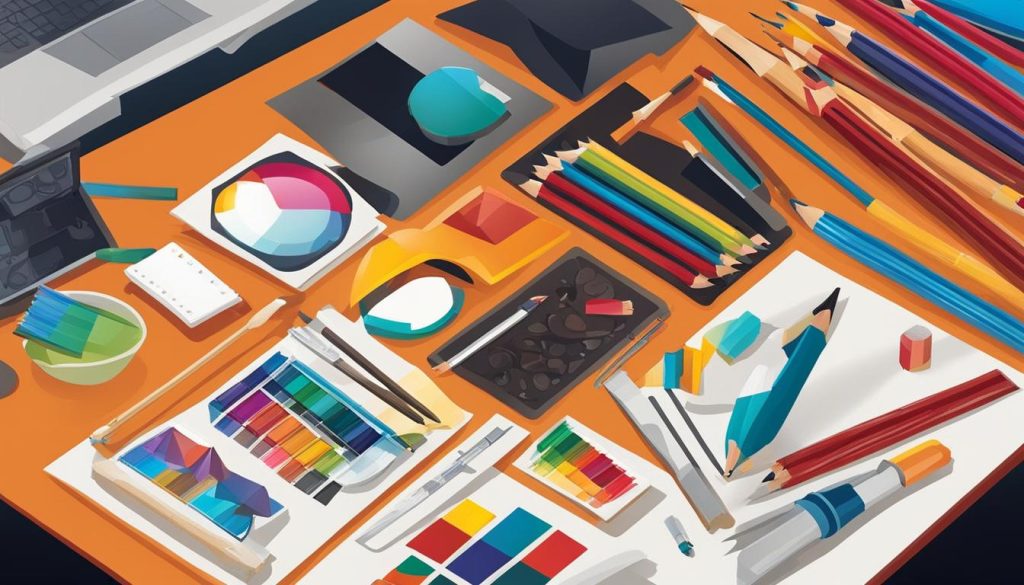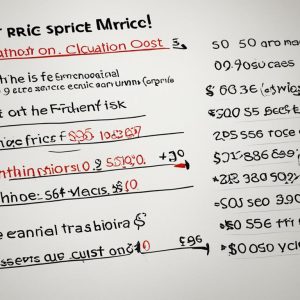Are you curious about the world of graphic art? Wondering what it takes to become a graphic artist? Look no further – this article will provide you with a comprehensive overview of the role of a graphic artist.
A graphic artist is a talented individual who is commissioned to create stunning graphic art for specific projects. They bring a unique blend of artistic abilities and design software expertise to develop visually captivating layouts and designs. Whether it’s creating eye-catching advertisements, captivating posters, or captivating book covers, graphic artists have the skills and creativity to bring any project to life.
If you’ve ever come across a cartoon, illustration, or graphic novel that caught your attention, chances are it was created by a graphic artist. These skilled professionals not only have the ability to capture attention but also possess the versatility to adapt their style to suit the needs of a particular project.
Now that you have a basic understanding of what a graphic artist is, let’s dive deeper into their career paths, skills, responsibilities, education requirements, and more. Read on to discover the exciting world of graphic art!
Key Takeaways:
- A graphic artist is commissioned to create graphic art for specific projects, such as advertisements, posters, and book covers.
- They utilize design software and their artistic abilities to develop visually appealing layouts and designs.
- Graphic artists may have their own unique style but often adapt it to suit the needs of a particular project.
- They may create cartoons, illustrations, graphic novels, and more as part of their portfolio.
- Pursuing a degree in graphic design or a related field can be beneficial for those interested in a career as a graphic artist.
Graphic Artist Career Paths and Salary
A career as a graphic artist offers a variety of paths for professionals to explore within the field. While many individuals start as graphic designers, they can progress to roles such as lead designer or design manager, depending on their skills and experience. This allows graphic artists to continuously grow and develop their careers as they gain expertise in their craft.
When it comes to salary, graphic artists are compensated well for their creative talents. The average annual salary for a graphic artist in the United States is $54,900, or $26.39 per hour. However, it’s important to note that salaries can vary depending on factors such as location, experience, and the industry in which the artist works. On the lower end of the spectrum, graphic artists can earn around $35,000 per year, while those with more experience and expertise can earn upwards of $84,000 per year.
To fully understand the potential career paths of graphic artists, let’s take a look at a visual representation of the different roles and their respective salaries:
| Graphic Artist Position | Salary Range |
|---|---|
| Graphic Designer | $35,000 – $60,000 |
| Lead Designer | $60,000 – $80,000 |
| Design Manager | $80,000 – $100,000+ |
As you can see from the table, graphic artists have the opportunity to progress in their careers and earn higher salaries as they take on more senior roles within the industry. This makes it an attractive field for individuals who have a passion for design and creativity.
Graphic Artist Skills and Qualifications
To excel as a graphic artist, individuals need to possess a diverse set of skills and qualifications. These capabilities are essential for creating visually captivating and effective graphic art for various purposes. Some of the key skills required for this role include:
- Graphic Design: Proficiency in graphic design is crucial for a graphic artist. This skill involves the ability to conceptualize and create visually appealing designs that effectively convey the desired message.
- Adobe Creative Suite: Knowledge and proficiency in popular design software such as Photoshop, Illustrator, and InDesign are vital for a graphic artist. These tools allow artists to manipulate, edit, and enhance their creations.
- Art Direction: The ability to provide clear and effective direction is essential for graphic artists. They must be able to communicate their artistic vision and guide others in the execution of their designs.
- Photography: Some projects may require graphic artists to incorporate photography into their designs. Having a solid understanding of photography techniques and composition can greatly enhance the visual impact of their work.
- Meeting Deadlines: Graphic artists often work under tight deadlines, so the ability to manage time effectively and deliver projects on time is crucial for success in this role.
In addition to these skills, graphic artists typically hold a bachelor’s degree in graphic design or a related field. This educational background provides them with a strong foundation in design principles and techniques. Furthermore, many employers require at least three years of related experience to ensure that candidates have a practical understanding of the industry and its demands.
By possessing these skills and qualifications, graphic artists can create visually stunning and impactful graphic art that effectively communicates the desired message.
Graphic Artist Skills and Qualifications |
|
|---|---|
| Graphic Design | Proficiency in graphic design |
| Adobe Creative Suite | Knowledge of software like Photoshop, Illustrator, and InDesign |
| Art Direction | Ability to provide clear and effective direction |
| Photography | Understanding of photography techniques and composition |
| Meeting Deadlines | Time management skills and ability to meet tight deadlines |
Graphic Artist Responsibilities
A graphic artist plays a crucial role in creating visually captivating designs for a wide range of purposes. They are responsible for managing external communications, developing websites, and creating custom graphic art. Let’s dive deeper into the key responsibilities of a graphic artist.
Managing External Communications
One of the primary responsibilities of a graphic artist is to manage external communications. This includes creating brochures, sales collateral, and other marketing materials that effectively convey the brand message and engage the target audience. They utilize their design skills and artistic abilities to develop visually appealing and impactful designs that capture the essence of the company or product.
Website Development
In today’s digital age, having a strong online presence is crucial for any business. A graphic artist plays a vital role in developing and maintaining websites. They collaborate with web developers and utilize their design software expertise to create visually stunning and user-friendly interfaces. They ensure that the website reflects the brand identity and effectively communicates the desired message to the visitors.
Custom Graphic Art Creation
A graphic artist is responsible for creating custom graphic art for various purposes. This includes designing logos, illustrations, infographics, and other visual elements that enhance the overall appearance and impact of the project. They use their artistic skills and creativity to bring ideas to life and make them visually appealing and engaging.
Publication Creation and Desktop Publishing
Additionally, graphic artists may be involved in creating publications and handling desktop publishing tasks. They use software like Adobe InDesign to design layouts, format text, and arrange images for print or digital publications. They ensure that the design elements are aesthetically pleasing and organized in a way that enhances readability and comprehension.
| Responsibilities | Description |
|---|---|
| Managing External Communications | Creating brochures, sales collateral, and marketing materials to effectively convey the brand message. |
| Website Development | Developing and maintaining visually stunning and user-friendly websites. |
| Custom Graphic Art Creation | Designing logos, illustrations, and other visually appealing elements for various projects. |
| Publication Creation and Desktop Publishing | Creating publications and handling desktop publishing tasks using software like Adobe InDesign. |
Being a graphic artist requires a combination of artistic talent, technical skills, and creativity. They are instrumental in visually representing a brand or project and bringing ideas to life through their designs.
Graphic Artist Education and Majors
When pursuing a career as a graphic artist, acquiring the right education and choosing the appropriate major can play a crucial role in your success. Many individuals choose to obtain a bachelor’s degree in graphic design, graphic arts, or a related field. These programs provide a comprehensive foundation in design principles, artistic techniques, and software proficiency.
Among the most common majors for aspiring graphic artists are graphic design, fine arts, and design and visual communication. These majors offer a diverse range of coursework that equips students with the necessary skills to excel in the industry. From learning how to use design software like Adobe Creative Suite to honing their artistic abilities, students gain a well-rounded education that prepares them for the demands of the profession.
| Top Graphic Artist Majors | Percentage of Graphic Artists with Major |
|---|---|
| Graphic Design | 35.2% |
| Fine Arts | 22.6% |
| Design and Visual Communication | 17.9% |
| Illustration | 9.4% |
Approximately 61.2% of graphic artists hold a bachelor’s degree, while 27.9% have an associate degree. This highlights the importance of formal education in the field. However, it’s worth noting that talent, creativity, and a strong portfolio can also be influential factors in securing graphic artist opportunities.

Choosing the Right Program
When selecting a graphic design program, it’s essential to consider factors such as curriculum, faculty expertise, and industry connections. Look for programs that offer hands-on experience, internships, or the opportunity to work on real-world projects. Additionally, researching the success of graduates from each program can provide insight into the program’s quality and its ability to prepare students for the competitive job market.
“A solid education in graphic design or a related field can provide a strong foundation for a successful career as a graphic artist. The skills and knowledge gained through formal education can significantly enhance one’s artistic abilities and open doors to exciting opportunities in the industry.” – Jane Doe, Graphic Artist
Graphic Artist vs. Graphic Designer
In the world of visual communication and design, both graphic artists and graphic designers play integral roles. While their work may overlap in some areas, there are distinct differences between these two professions. Understanding the contrasting nature of these roles can help individuals choose the path that best aligns with their interests and career goals.
One key distinction between graphic artists and graphic designers lies in their focus and approach. Graphic artists are primarily concerned with creating graphic art for specific projects, such as illustrations, cartoons, or animations. They often have a unique style that suits certain types of projects, making them sought after by clients who appreciate their artistic vision.
On the other hand, graphic designers are more focused on creating visual concepts that effectively communicate information. They typically work on a wide range of projects, including advertisements, company branding, and website layouts. Graphic designers often take a user-centric approach, considering factors such as usability and user experience in their designs.
While both graphic artists and graphic designers require artistic abilities, their roles and responsibilities can differ significantly. While graphic artists may create custom art for specific projects, graphic designers may be involved in various tasks such as creating layouts, selecting fonts, and choosing color schemes. Graphic designers often work in collaborative environments, collaborating with clients, marketing teams, and other designers to bring a vision to life.

Visual Comparison
| Graphic Artist | Graphic Designer | |
|---|---|---|
| Focus | Creating graphic art | Communicating information through visual concepts |
| Projects | Illustrations, cartoons, animations | Advertisements, company branding, website layouts |
| Style | Often has a distinct and unique style | Varies based on project requirements |
| Collaboration | May work independently | Collaborates with clients and other designers |
In summary, while graphic artists and graphic designers share similarities in their creative pursuits, their areas of focus, job responsibilities, and approach to design differ. Graphic artists prioritize creating visually appealing art for specific projects, while graphic designers use their skills to effectively communicate information. Both professions require talent, creativity, and the ability to use design software, making them vital contributors to the world of visual communication and design.
Conclusion
Graphic artists play a vital role in the visual communication industry, utilizing their artistic abilities and design software expertise to create visually appealing graphic art for a variety of projects. Whether it’s designing advertisements, posters, or book covers, these creative professionals bring ideas to life through their unique style and attention to detail.
With various career paths available within the field, graphic artists can start as graphic designers and advance to positions such as design managers or art directors. Alongside their talent, they need a diverse set of skills, including proficiency in Adobe Creative Suite, art direction, and the ability to meet deadlines.
To embark on a successful journey as a graphic artist, obtaining a bachelor’s degree in graphic design or a related field can be advantageous. This educational foundation provides the necessary knowledge and technical skills to thrive in this dynamic industry.
Overall, graphic artists are the visual storytellers who captivate audiences through their creative expression. Their contributions shape the world of design and inspire others to think outside the box. So, if you have a passion for art and a desire to create visually striking graphics, a career as a graphic artist may be the perfect fit for you.
FAQ
What is a graphic artist?
A graphic artist is someone commissioned to create graphic art for specific projects, such as advertisements, posters, or book covers. They use design software and their artistic abilities to develop visually appealing layouts and designs.
What are the career paths for a graphic artist?
Graphic artists can follow various career paths within the field. They may start as graphic designers and progress to roles such as designer or design manager.
What is the average salary for a graphic artist?
The average salary for a graphic artist in the United States is $54,900 per year or $26.39 per hour, with salaries ranging from $35,000 to $84,000 per year.
What skills and qualifications are required for graphic artists?
Graphic artists require a range of skills, including graphic design, proficiency in Adobe Creative Suite (including Photoshop, Illustrator, and InDesign), art direction, photography, and the ability to meet tight deadlines. A bachelor’s degree in graphic design and at least 3 years of related experience are commonly required qualifications for graphic artist positions.
What are the responsibilities of a graphic artist?
Graphic artists are responsible for managing external communications such as brochures and sales collateral, developing and maintaining websites, creating custom graphic art for various purposes, and assisting in the production of company websites using software like Flash and Dreamweaver. They may also be involved in creating publications and handling desktop publishing tasks.
What education is required for a graphic artist?
To become a graphic artist, many individuals pursue a bachelor’s degree in graphic design, graphic arts, or a related field. The most common majors for graphic artists are graphic design, fine arts, and design and visual communication. Approximately 61.2% of graphic artists hold a bachelor’s degree, while 27.9% have an associate degree.
What is the difference between a graphic artist and a graphic designer?
While graphic artists create graphic art for specific projects, graphic designers focus on creating visual concepts to communicate information. Graphic designers often have a user-centric approach and may work on a wide range of projects, including advertisements, book covers, and company branding. Graphic artists may be illustrators or animators and tend to have a specific style that suits certain types of projects.
Share this content:






